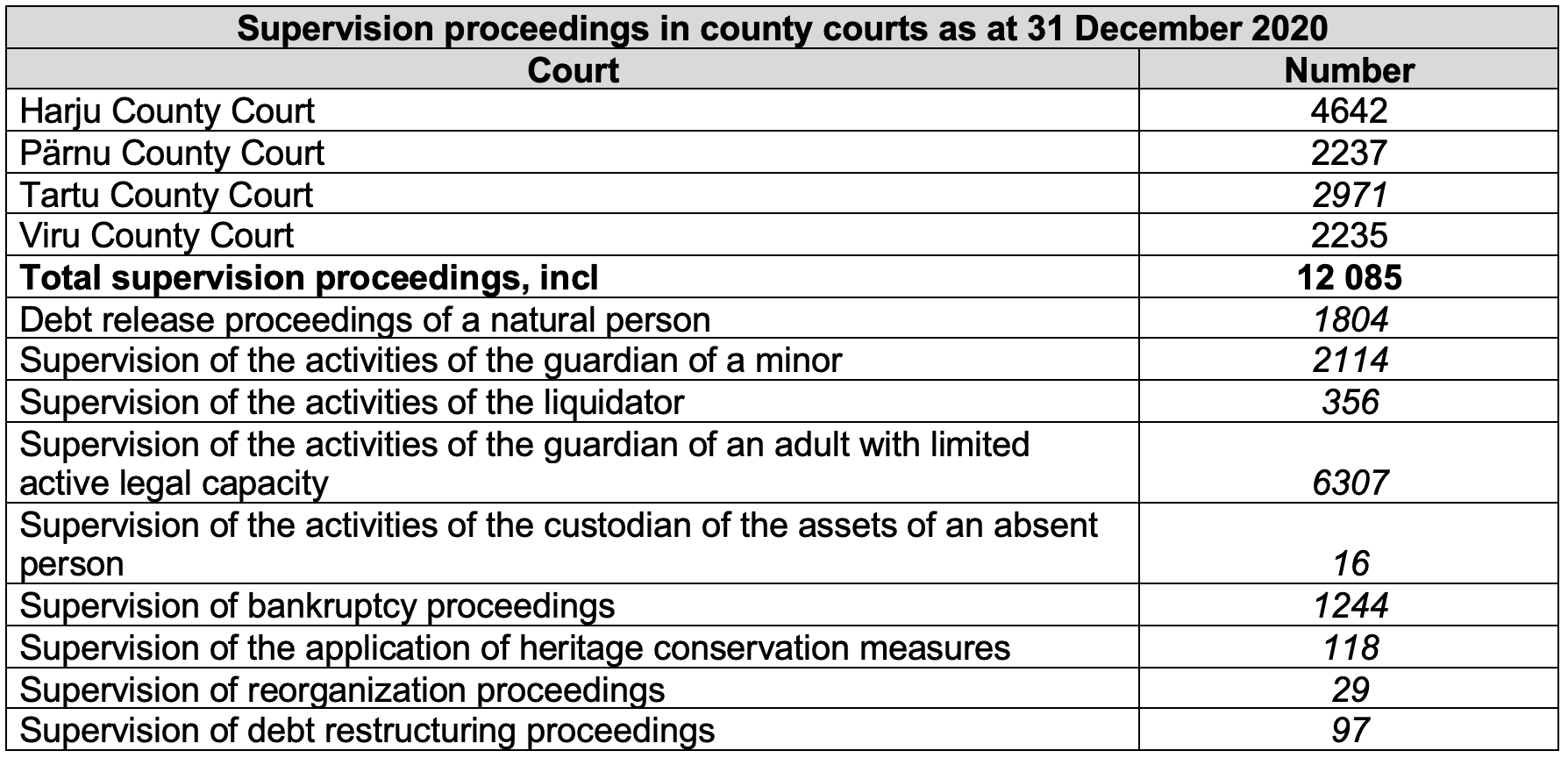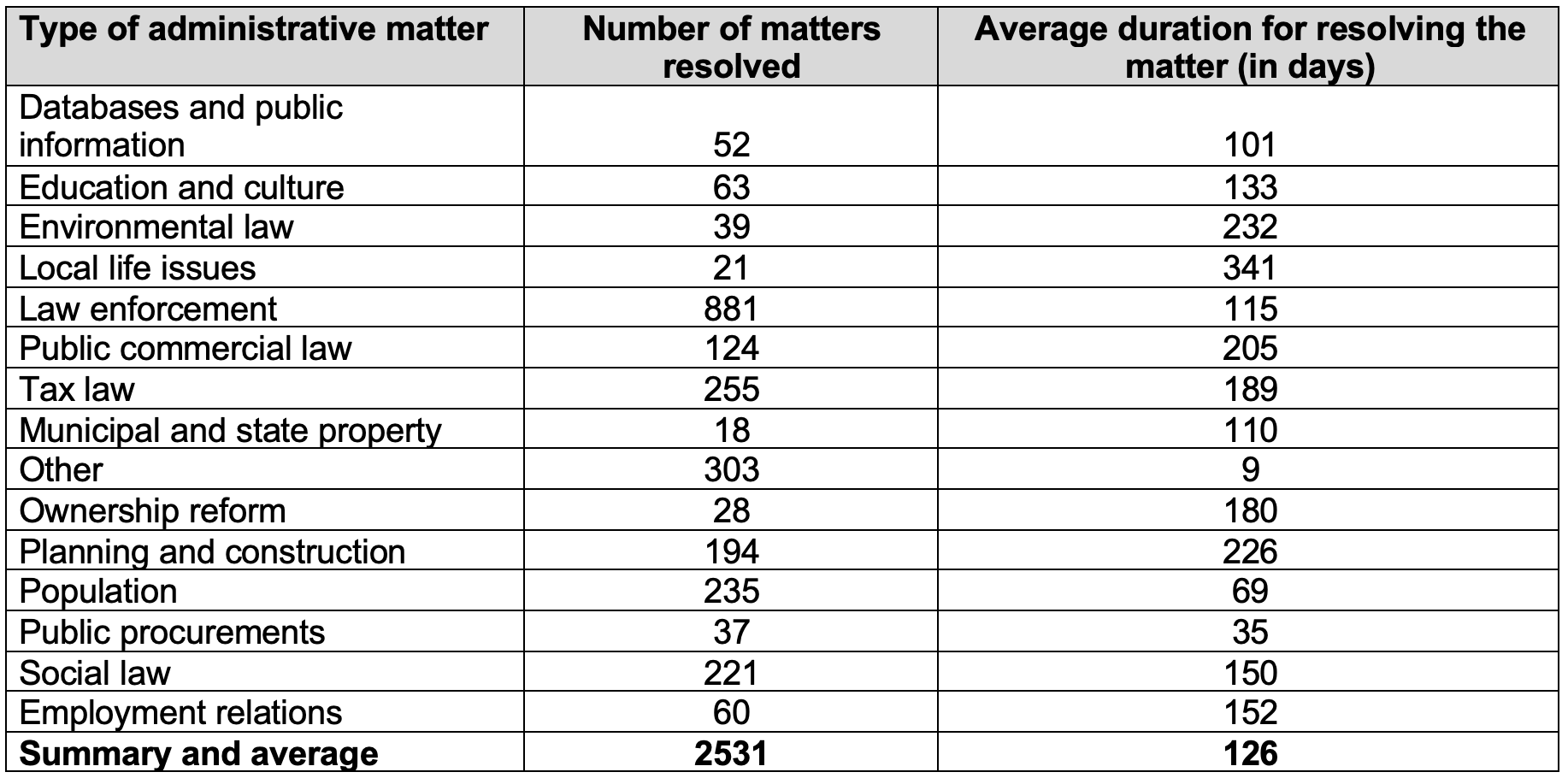Külli Luha
Analyst of the Courts Division of the Ministry of Justice
In 2020 county courts processed 33 658 civil matters (3.0% more than in 2019) and 45 566 matters of expedited procedures of payment orders (15.6% more than in 2019), 14 440 criminal procedure matters[1], including 5210 criminal matters (5.8% less than in 2019); and 5 952 misdemeanour matters (14.3% less than in 2019). Administrative courts processed 2 737 administrative matters (8.1% more than in 2019).
The figures 1-3 below illustrate the number of criminal and misdemeanour matters, civil and administrative matters that were brought before county and administrative courts over the last eight years. The trend lines on the graphs show the change in the workload of the courts during this period.

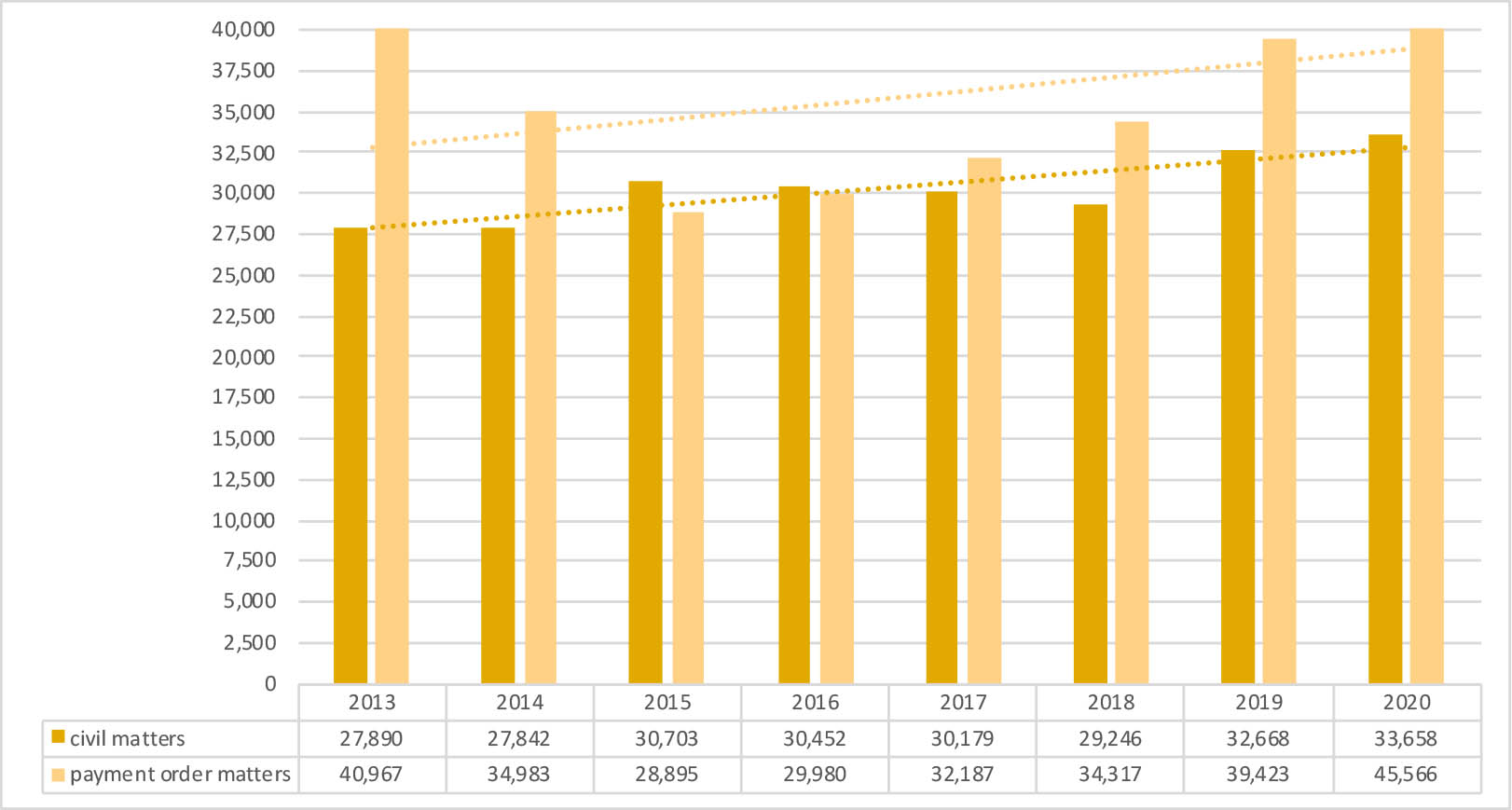
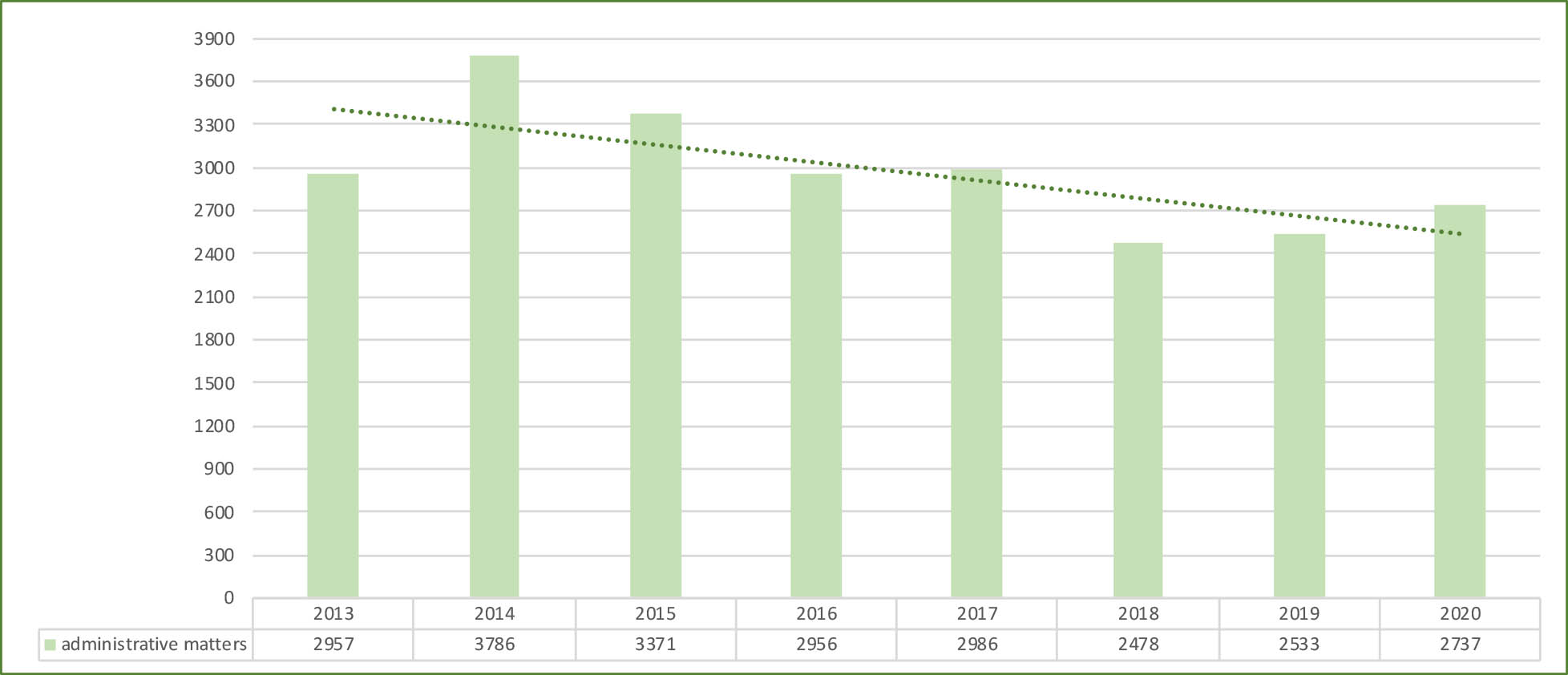
The circuit courts received the total of 2 815 civil matters (1.8% less than in 2019), 1 245 administrative matters (11.6% more than in 2019), 1 874 criminal procedure matters (5.8% less than in 2019) and 119 misdemeanour matters (27.4% more than in 2019) in appeals and appeals against court rulings. The figure 4 below illustrates the change in the number of matters brought before circuit courts over the last eight years in all types of proceedings with the trend lines indicating the change in the workload of circuit courts.
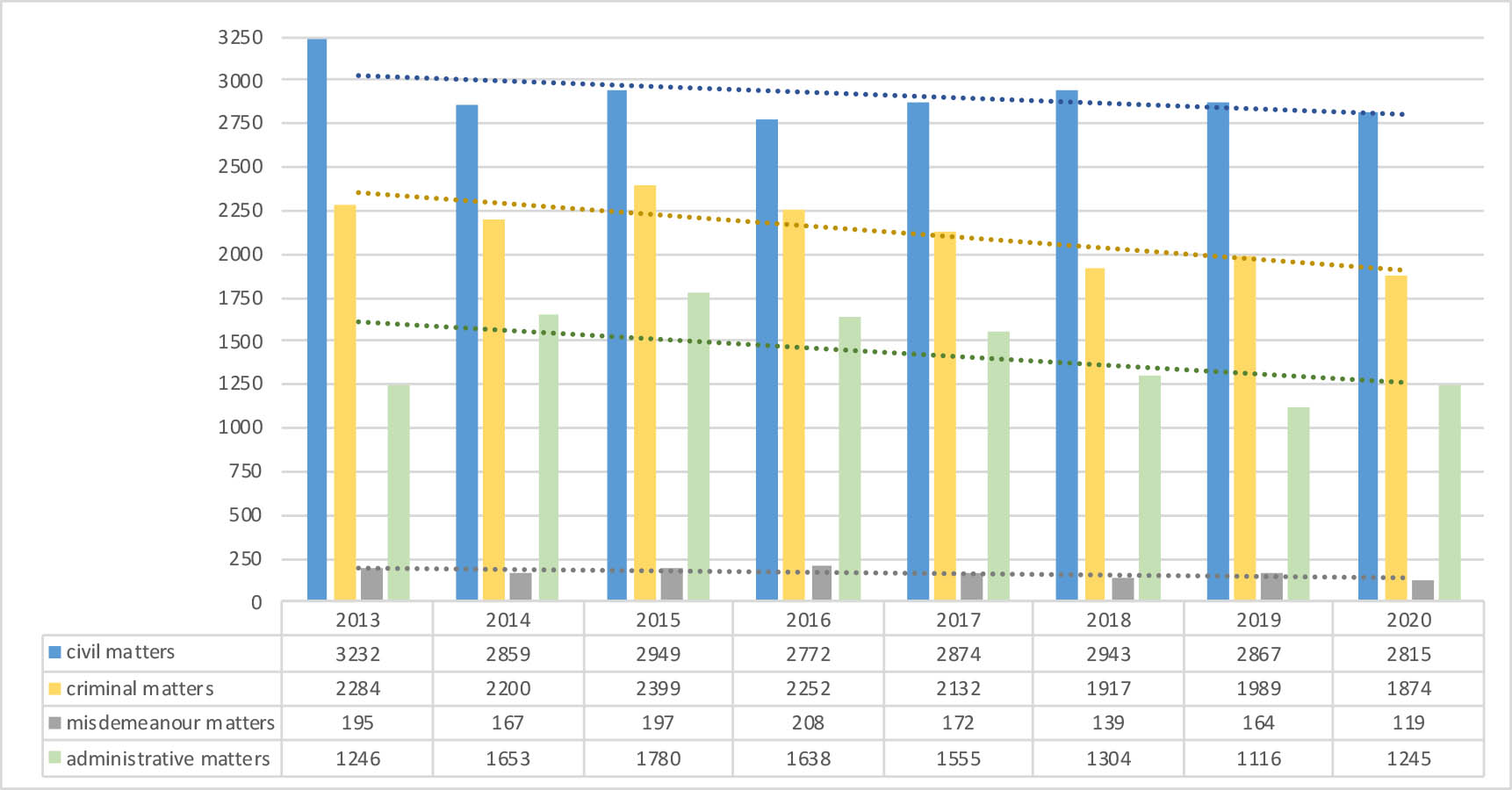
The more detailed data on the procedural statistics of courts of first and second instance in 2020 by type of proceedings have been published on the web of courts.[3]
Workload of a judge on the basis of matters received during 2020
In 2020 civil matters were distributed to the total of 83.1[4] judges in county courts, including 37.3 judges in Harju County Court, 12.6 in Pärnu County Court, 19.9 in Tartu County Court and 13.3 in Viru County Court. Criminal and misdemeanour proceedings were distributed in county courts to the total of 55.2 judges, including 21.9 judges in Harju County Court, 7.5 in Pärnu County Court, 12.5 in Tartu County Court and 13.3 in Viru County Court. Since 12 April 2020 the county courts have total of 152 positions of judges, but taking into account the vacancies of judges and consequent suspensions and long absences, the share of vacancies or temporarily vacant posts in county courts was 9.0% (incl. 11.6% in Harju County Court, 4.3% in Pärnu County Court, 10.0% in Tartu County Court and 5.0% in Viru County Court).
During 2020 administrative matters were distributed to the total of 22.5 judges, including 14.85 judges in Tallinn Administrative Court and 7.65 judges in Tartu Administrative Court. Since 12 April 2020 the administrative courts have total of 25 positions of judges. Considering the vacant positions of judges and the resulting suspensions and long absences, the share of vacant or temporarily vacant positions in administrative courts was 10.0% (incl. 12.6% in Tallinn Administrative Court and 4.4% in Tartu Administrative Court).
In the civil chambers of circuit courts the civil matters were distributed to 21.2 judges, including 15.2 judges in Tallinn and 6 judges in Tartu. In criminal chambers the criminal matters were distributed to 12.2 judges, including 7.4 judges in Tallinn and 4.8 in Tartu and administrative matters in administrative chambers were distributed to 11 judges, including 6.5 judges in Tallinn and 4.5 judges in Tartu. There are total of 46 positions of judges in the circuit courts. By taking vacancies and consequent suspensions and long absences into account, the share of vacancies or unfilled positions was 3.5%.
The figure below indicates the average workload of a so-called statistical judge in all types of proceedings based on the matters received in 2020:
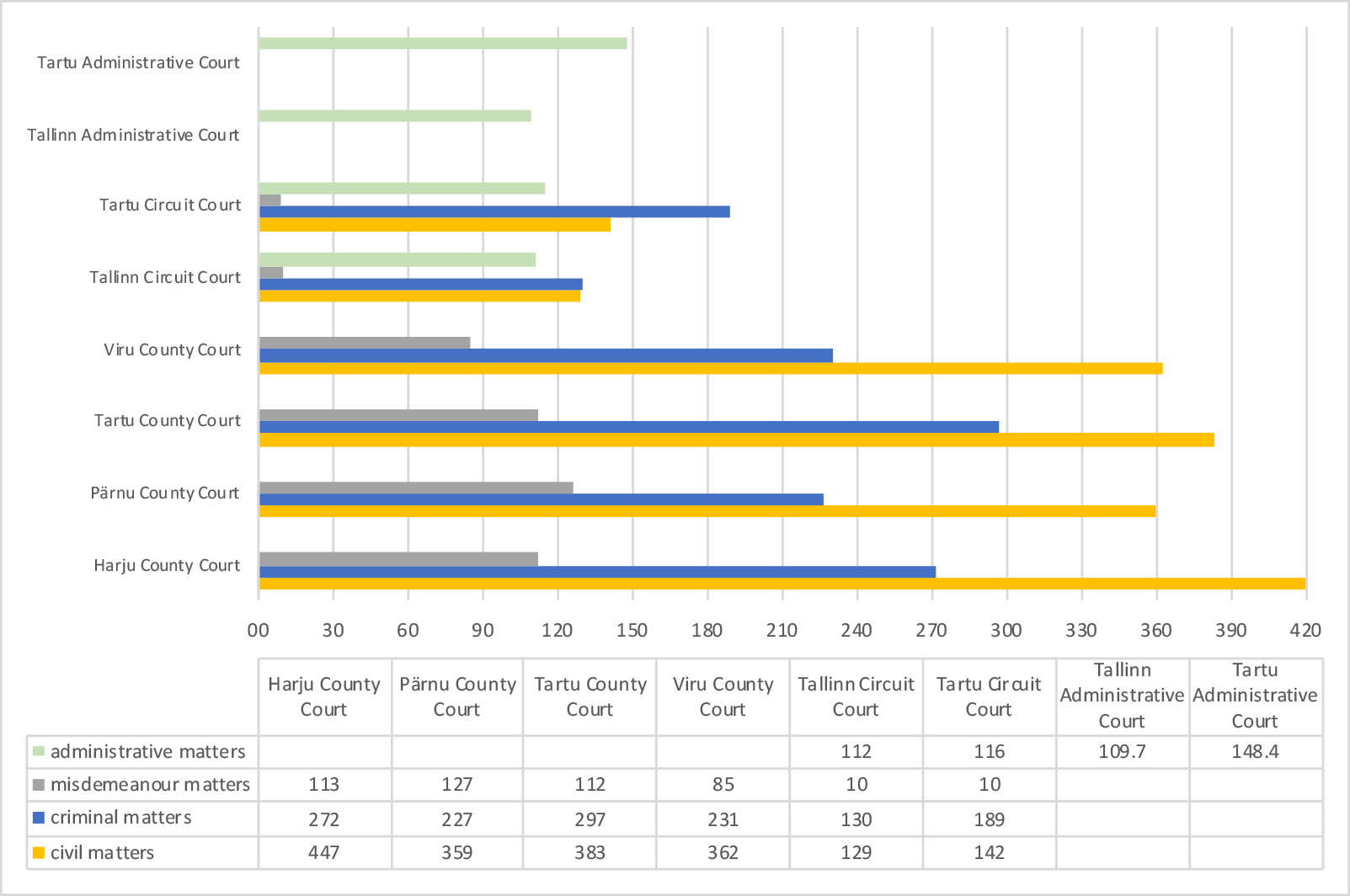
Adjudication of matters in county courts: civil matters
The total of 33 286 civil matters were adjudicated by county courts, 16 558 of which in Harju County Court, 4 285 in Pärnu County Court, 7 621 in Tartu County Court and 4 822 in Viru County Court. 56.8% of the resolved civil matters were actions of different statistical categories.
Considering the content of the adjudicated matters, it can be said that the usual majority were the matters of family law, law of obligations and General Part of the Civil Code Act (TsÜS). Compared to 2019 the number and share of these matters has increased by 9.2%, amounting to 79.2%. Compared to the past, the number and share of bankruptcy matters also somewhat increased. An overview of the content of resolved civil matters by type is provided in Figure 6.
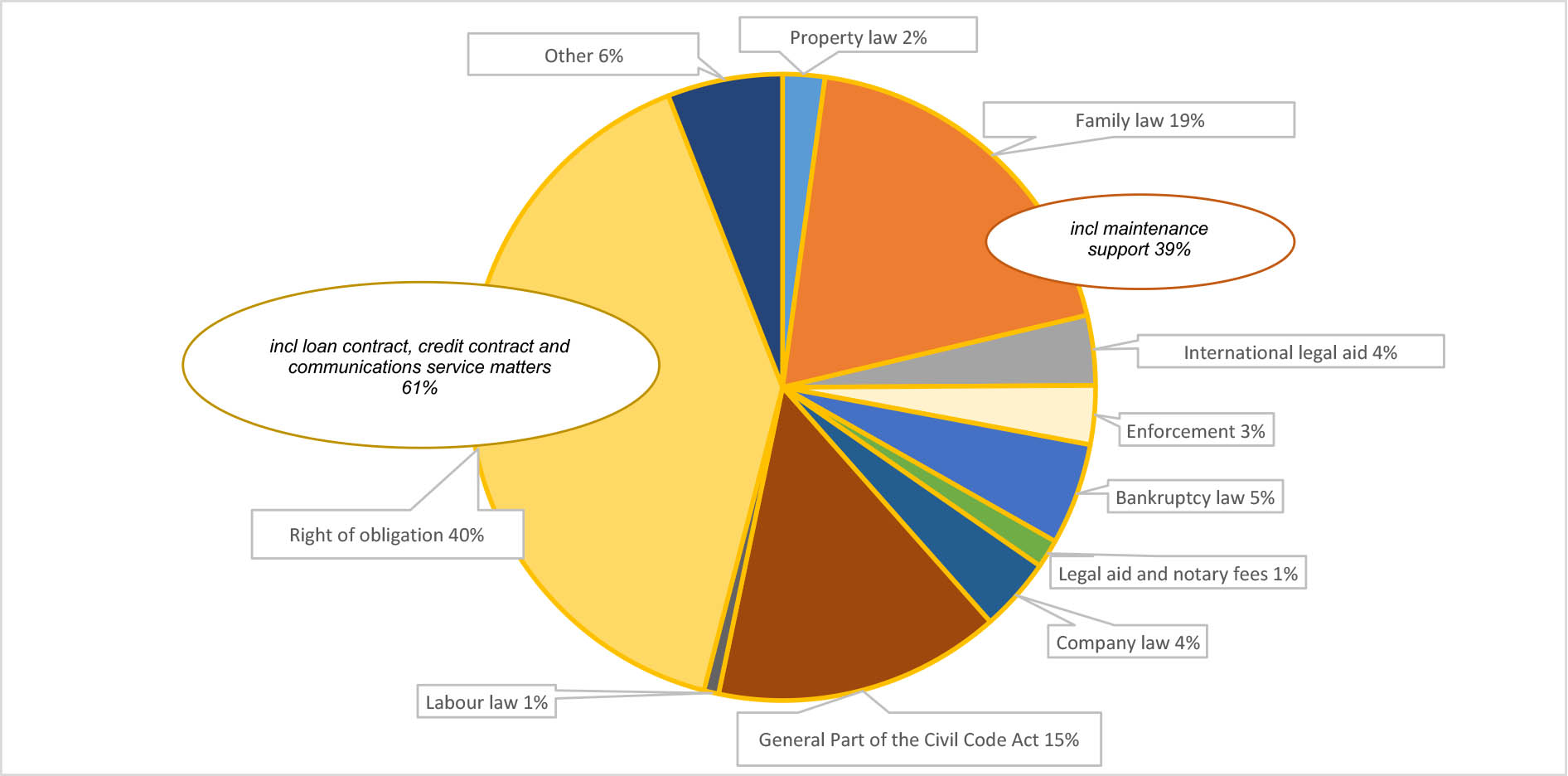

The average length of proceedings of civil matters adjudicated in 2020 was 95 days, including 110 days in Harju County Court, 87 days in Pärnu County Court, 74 days in Tartu County Court and 84 days in Viru County Court. The average length of 18 920 civil matters adjudicated in the action was 126 days. The longest matters adjudicated in action are the so-called full-length proceedings. The following table indicates the average length of adjudication of such matters by types:
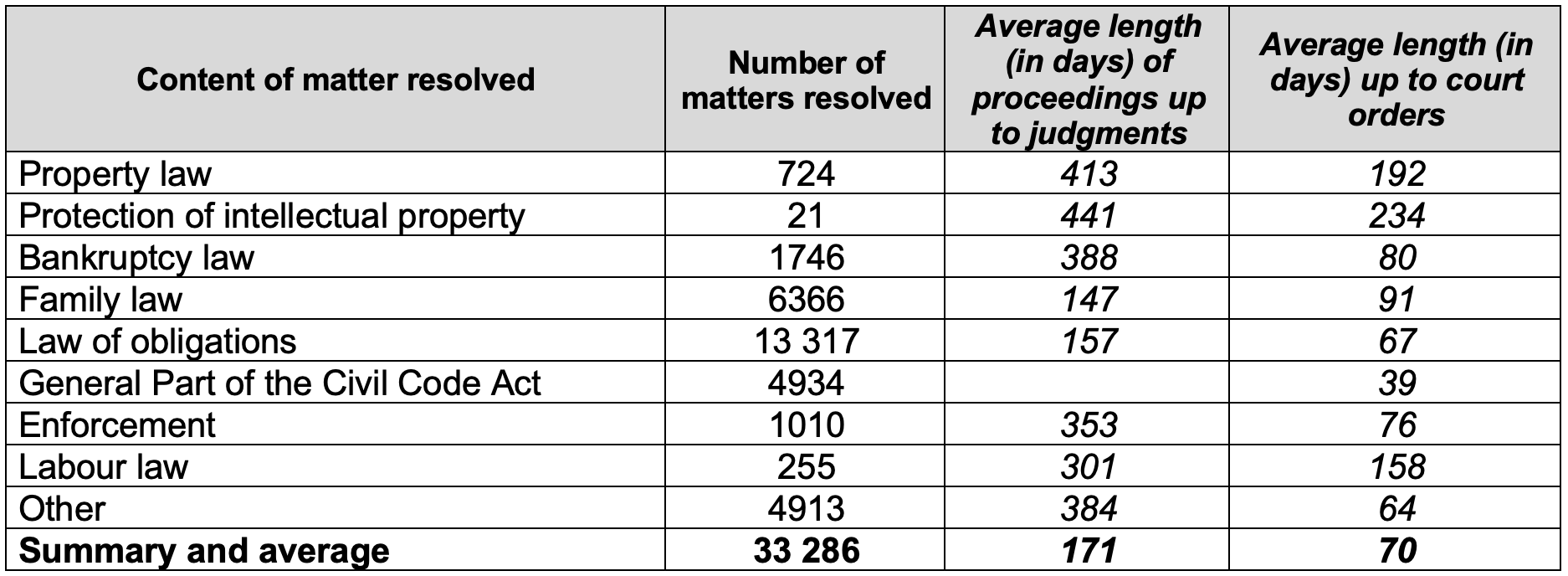
The table below indicates the number of matters of law of obligations of the highest proportion and the average duration for resolving the matter:

In 2020 the total of 14 026 supervision proceedings were conducted in county courts, 64% of which were supervisions over the activities of an adult with limited active legal capacity or a guardian of a minor, 14.3% was supervision of bankruptcy proceedings and 14.8% was debt release proceedings of natural persons.
The table below indicates the distribution of supervision proceedings pending in county courts as of 31 December 2020 by type:
Adjudication of matters in county courts: criminal and misdemeanour matters
The county courts adjudicated the total of 14 459 criminal procedure matters distributed as follows: 35.4% were criminal matters (16.8% of which were submitted for expedited procedure), 30.2% were matters of judges in charge of the execution of court judgments and 27.9% were preliminary investigation judge matters (Figure 8).

The total of 5114 criminal matters were resolved in county courts: 2040 in Harju County Court; 779 in Pärnu County Court; 1264 in Tartu County Court; 1031 in Viru County Court. The vast majority, i.e. 72.6% (3712) of the criminal matters were resolved in settlement proceedings (incl. 670 in expedited proceedings), 973 in alternative proceedings (incl. 304 in expedited proceedings), 67 in summary proceedings (incl. 11 in expedited proceedings) and 362 in general proceedings.
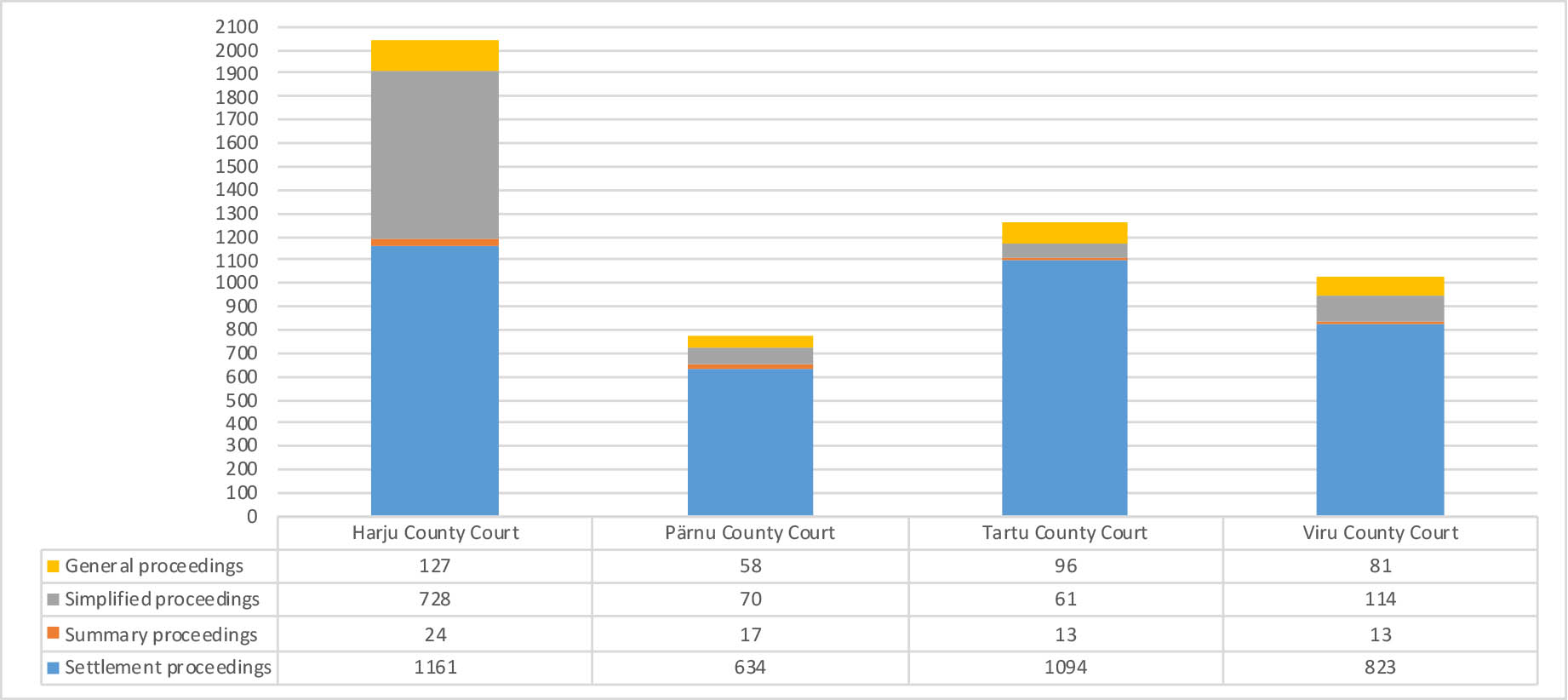
The table below shows the average length for resolving the criminal matters:

The total of 362 criminal matters were resolved in general proceedings in county courts, in 12.0% matters of which the victim and/or accused was a minor. The distribution of matters of general proceedings by number of the accused persons is illustrated in Figure 10.

The table below shows the number of criminal matters resolved in general proceedings and the time taken to resolve them based on the number of the accused:

The total of 4 039 matters of preliminary investigation judge were resolved, 34.8% of which were search matters. The following table shows the type distribution of the matters of preliminary investigation judge (Figure 11) and the time taken to resolve them:


In 2020 the total of 4 367 matters of judge in charge of the execution of court judgments were resolved, the majority, i.e. 34.9%, of which were the matters of the early release of a convicted person.
The total of 5 926 misdemeanour matters were resolved in county courts: 2416 in Harju County Court; 958 in Pärnu County Court; 1383 in Tartu County Court; 1169 in Viru County Court. It took an average of 47 days to resolve misdemeanour matters in court and an average of 70 days to resolve misdemeanour complaints.
Adjudication of matters in administrative courts
In 2020 the administrative courts adjudicated the total of 2 531 administrative matters: 1 450 matters in Tallinn Administrative Court and 1 081 in Tartu Administrative Court. According to the content of the complaint, 34.8% of the resolved matters were law enforcement matters, 10.1% were tax law matters, 9.3% population matters, 7.7% planning and construction matters and 4.9% public commercial law matters (Figure 12).
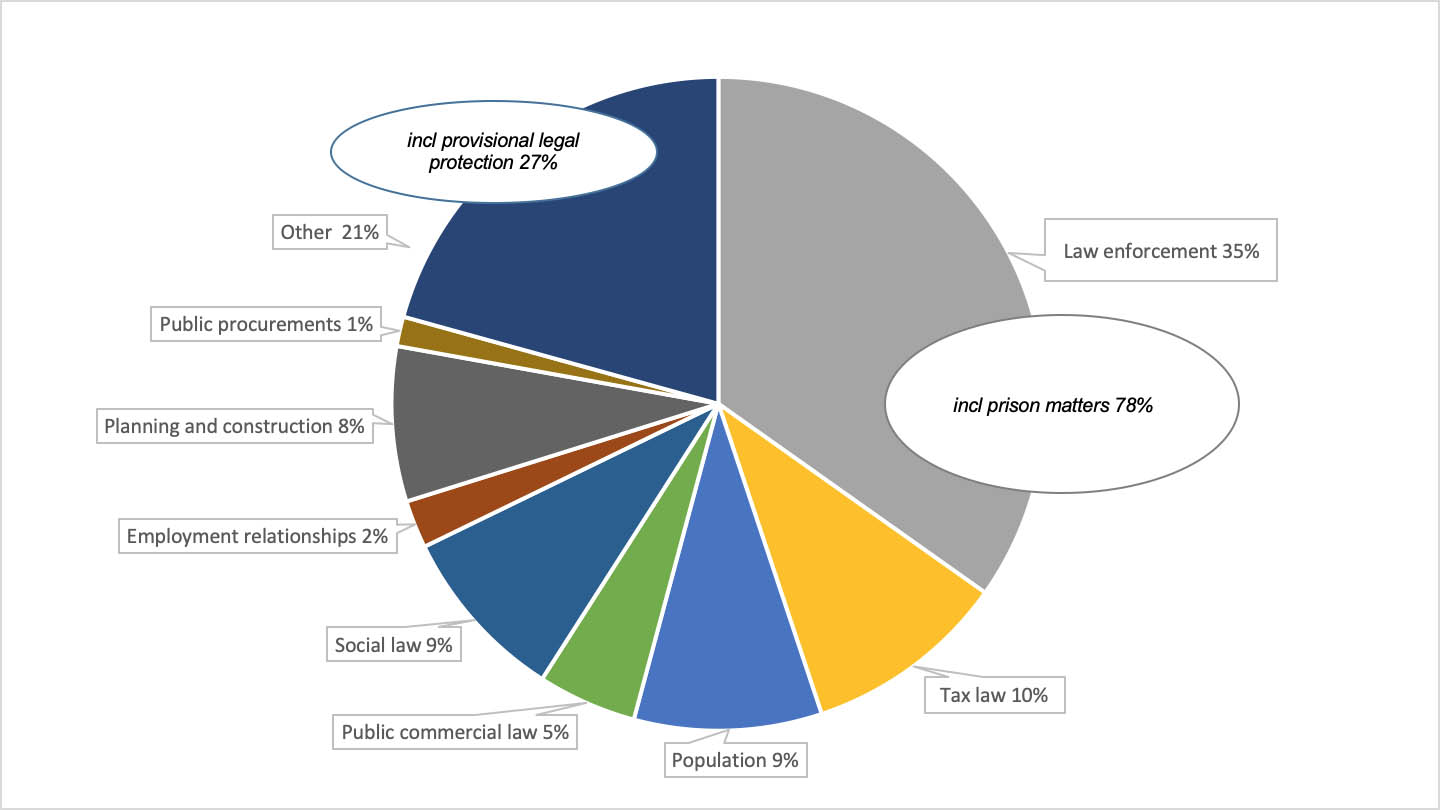
The average length of adjudication of administrative matters in 2020 was 126 days in Tallinn Administrative Court and 126 days in Tartu Administrative Court. The average duration of resolving the administrative matters has been indicated in the table below:
Adjudication of matters in circuit courts: civil matters
During 2020 the total of 2 829 civil matters were adjudicated in circuit courts (2 014 in Tallinn Circuit Court and 815 in Tartu Circuit Court), including 1 142 appeal proceedings and 1 687 matters of appeals against court rulings. Circuit courts adjudicated civil matters in appeal procedure with an average duration of 182 days (206 days in Tallinn Circuit Court and 123 days in Tartu Circuit Court) and in appeals against court rulings with an average duration of 65 days (83 in Tallinn Circuit Court and 21 in Tartu Circuit Court).
More than one third of the circuit courts’ substantively adjudicated matters were the law of obligation matters (29.8% of adjudicated matters) and family law matters (14.2%). The distribution of civil matters by content in circuit courts has been indicated in Figure 13:
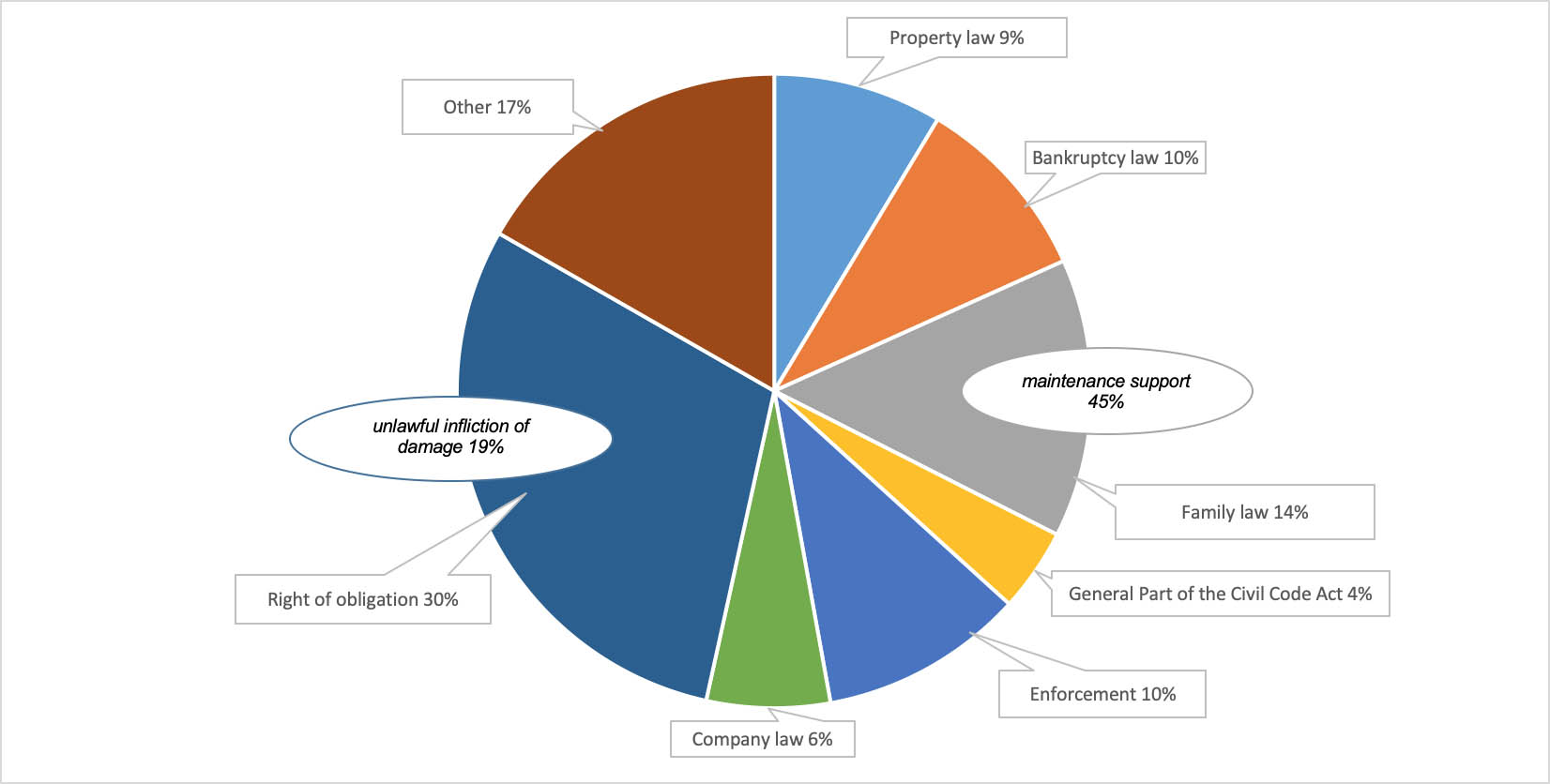

The share of matters resolved in circuit courts accounted for 5.6% of county court decisions.
Adjudication of matters in circuit courts: criminal and misdemeanour matters
In 2020 the circuit courts adjudicated the total of 1 860 criminal procedure matters (968 in Tallinn Circuit Court and 892 in Tartu Circuit Court), including 380 criminal matters in appeal procedure, 1 292 matters of appeals against court rulings and 169 matters initiated by circuit courts. The average duration of criminal matters in appeal procedure was 51 days (45 in Tallinn Circuit Court and 59 in Tartu Circuit Court). The matters of appeals against court rulings were adjudicated with an average duration of 15 days (16 in Tallinn Circuit Court and 14 in Tartu Circuit Court).
The quarter of the matters resolved in circuit courts were criminal matters (24.5%) and the largest number continued to be the matters of a judge in charge of the execution of court judgments (34.8% of the resolved matters) and 27.0% the matters of preliminary investigation judge. The more detailed distribution has been indicated in Figure 14 and the average duration to resolve matters by the same reported types has been indicated in the table below.
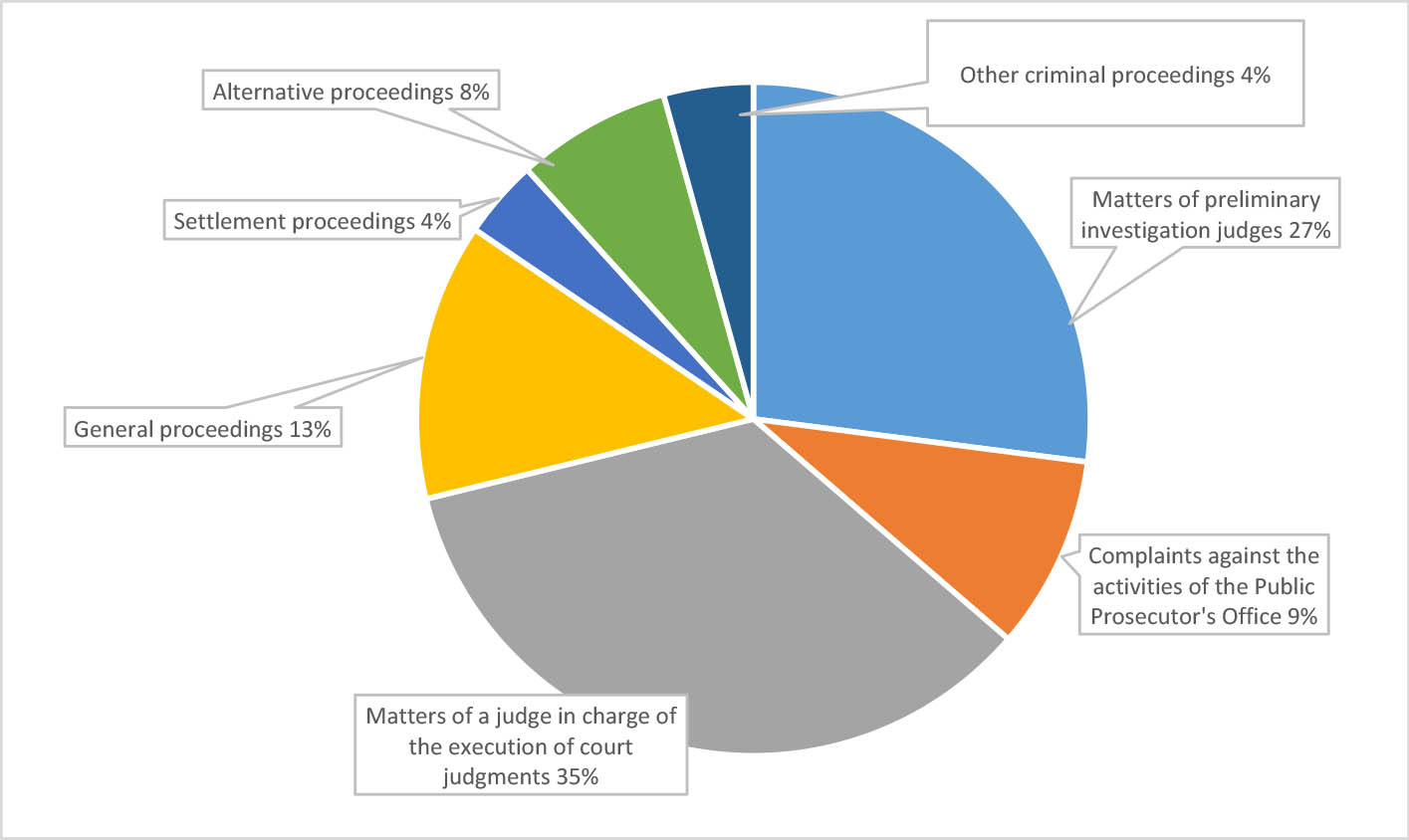

The share of matters resolved in circuit courts accounted for 9.7% of county court decisions.
The total of 122 misdemeanour matters were resolved, including 75 in Tallinn Circuit Court and 47 in Tartu Circuit Court.
Adjudication of matters in circuit courts: administrative matters
During 2020 the circuit courts adjudicated the total of 1 186 administrative matters (631 in Tallinn Circuit Court and 555 in Tartu Circuit Court), including 459 in appeal procedure and 727 administrative matters of appeals against court rulings. The circuit courts adjudicated the administrative matters in appeal procedure with an average duration of 192 days (124 in Tallinn Circuit Court and 301 in Tartu Circuit Court) and matters of appeal against court rulings with an average duration of 27 days (24 in Tallinn Circuit Court and 30 in Tartu Circuit Court).
In terms of content most law enforcement matters were resolved in circuit courts (36.8% of resolved matters). Tax law (10.8%) and population (8.8%) also had a larger share. Figure 15 indicates the administrative matters resolved in circuit courts by content and the following table shows the average duration for resolving the same types of matters.
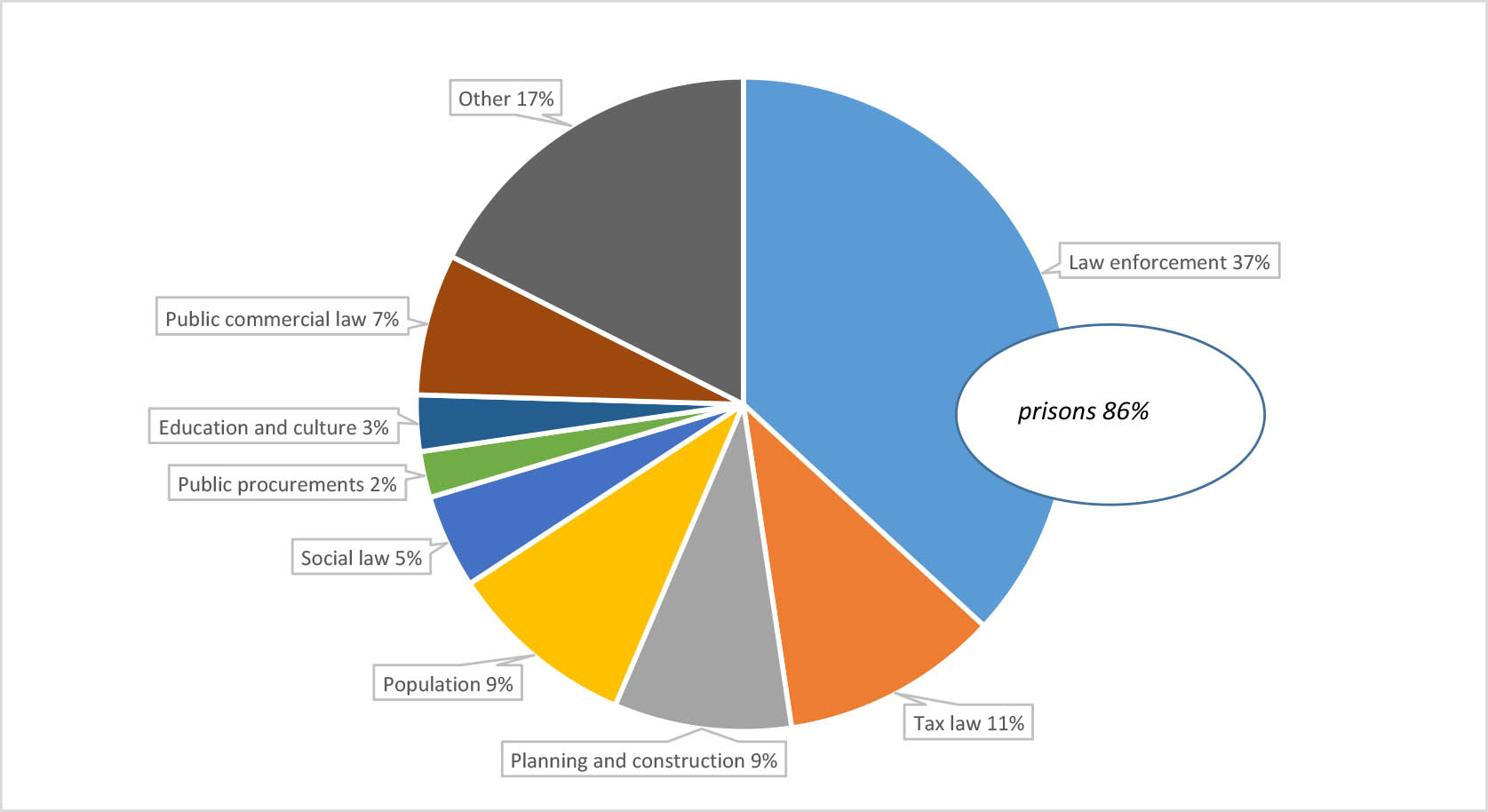
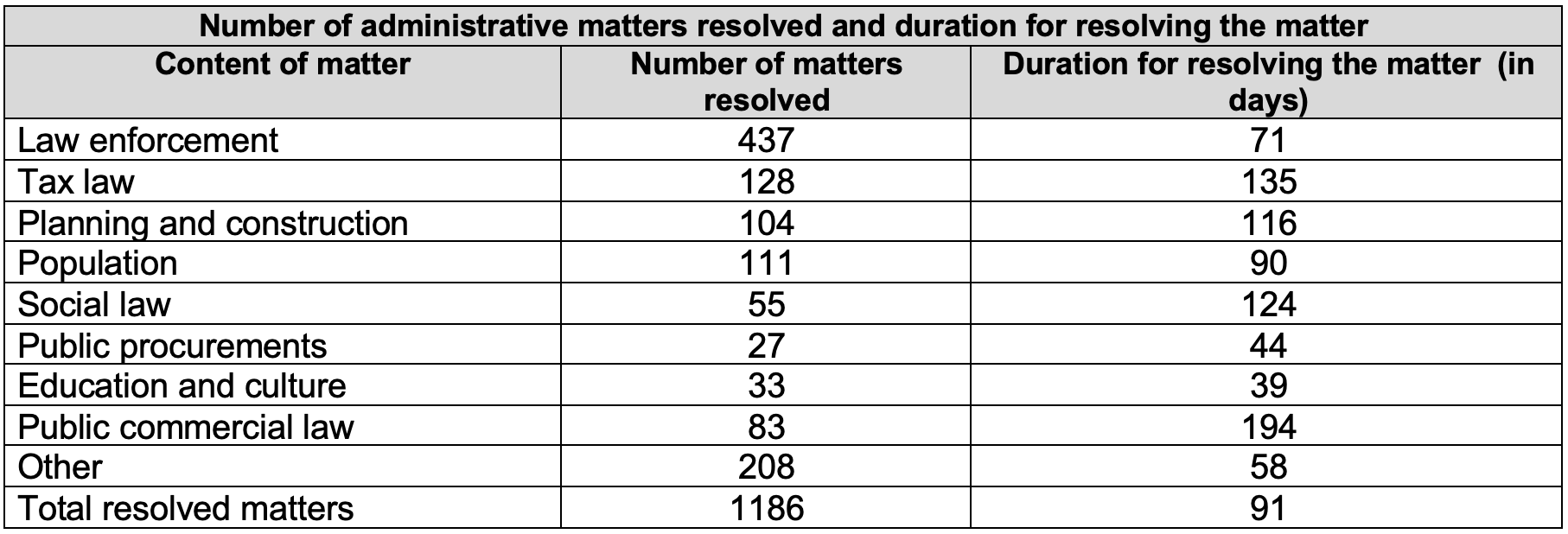
The share of matters resolved in circuit courts accounted for 33.4% of administrative court decisions.
Proportion of matters automatically distributed to judges in 2020
All courts of first and second instance use the functionality of appointing a person conducting the proceedings in the courts information system to distribute the matters to judges. Pursuant to § 37 of the Courts Act and the rules for uniform implementation of the courts information system[5] the matters are divided on the basis of a division of tasks plan and the principle of randomness. Exceptionally, the matters are assigned for manual enforcement for reasons listed in article 15 of the rules. The basic statistics for 2020 indicates that the vast majority of matters are automatically distributed, however, manual distribution still plays an important role:

The procedural year 2020, more special than the previous ones
2020 was a year when unconventional ways of dealing with things had to be found due to COVID-19 pandemic. In March last year, the Council for Administration of Courts issued recommendations to the courts for the administration of justice during an emergency.[6] The keywords of the recommendations were the continuation of administration of justice, primarily through remote working, written procedure and digital file.
The evidence that the administration of justice continued at more or less the usual rate and pace has been provided for on the previous pages. The subsequent analyses indicate how the consequences of the pandemic were reflected in the content of the cases. However, it can be stated here that the share of written proceedings increased even more in 2020 than before and the resolved matters included the types of cases which were all resolved in writing. The paperless procedure, i.e. the digital file, also enabled to resolve the matters outside the courthouses. The following is an overview of the share of written and paperless procedures (Figures 16 and 17):
Civil matters. The share of written proceedings in county courts increased by another 3% compared to the last year and thus 88.3% of all civil matters were resolved in writing in 2020, including 90.7% in Harju County Court, 89.0% in Pärnu County Court, 98.1% in Tartu County Court and 81.1% in Viru County Court. In essence, all matters of legal aid and notary fees and international law were settled in writing. The share of written proceedings in family and bankruptcy law matters was the lowest, 74.8% and 48.6% respectively. The largest share of written proceedings was 95.4% in the matters of law of obligation.
85.5% of the matters were resolved in written proceedings in circuit courts, including 84.9% in Tallinn Circuit Court and 87.2% in Tartu Circuit Court. International legal aid, legal aid costs and procedural costs, as well as debt restructuring proceedings, social welfare and the matters of the General Part of the Civil Code Act, were settled entirely by written procedure.
In 2020 41.6% of the matters in county courts were resolved in the paperless procedure, including 44.6% in Harju County Court, 35.6% in Pärnu County Court, 40.9% in Tartu County Court and 37.2% in Viru County Court. The share of paperless proceedings was the highest in the matters of law of obligation at 68.1%.
The share of paperless proceedings in circuit courts was 12.5% of the resolved matters.
Criminal procedure matters. The share of written proceedings was the most modest in this type of procedure. On average, 41.2% were settled in written proceedings in county courts, including 46.9% in Harju County Court, 48.0% in Pärnu County Court, 37.3% in Tartu County Court and 31.1% in Viru County Court. The share of written proceedings in the matters of a preliminary investigation judge was significantly higher than the average (71.6% of the resolved matters).
74.6% of the criminal matters were resolved in written proceedings in circuit courts, including 70.4% in Tallinn Circuit Court and 79.3% in Tartu Circuit Court.
The share of paperless proceedings in criminal court proceedings was 5.0%, which essentially means that 17.1% of the matters of a preliminary investigation judge were resolved in paperless proceedings.
The share of paperless proceedings in circuit courts was 14.0% of the resolved matters.
Misdemeanour matters. In this type of proceedings 27.4% of the matters were resolved in written proceedings in 2020, including 33.2% in Harju County Court, 28.6% in Pärnu County Court, 26.1% in Tartu County Court and 16.3% in Viru County Court. In essence, appeals against the decision or action of an extra-judicial body were resolved in a written procedure (the share of written proceedings was 45.5% of resolved matters).
In 2020 64.7% of the matters in county courts were resolved in paperless proceedings,
including 55.6% in Harju County Court, 71.0% in Pärnu County Court, 69.4% in Tartu County Court and 72.8% in Viru County Court. The share of paperless proceedings was the highest, i.e. 94.7%, in the matters of enforcement.
Administrative matters. The share of written proceedings increased somewhat further in 2020, i.e. by about 2%. 77.0% of the matters were resolved in written proceedings in Tallinn Administrative Court and 96.1% in Tartu Administrative Court. The share of written proceedings differed by type of matter, the largest share of written proceedings was in law enforcement and social law cases, where almost all matters were resolved in written proceedings last year. The share of written proceedings in population and public procurement matters was the smallest (less than half of the matters were resolved in writing).
91.1% of administrative matters were resolved in written proceedings in circuit courts, including 84.9% in Tallinn Circuit Court and 98.0% in Tartu Circuit Court.
43.5% of the administrative matters were resolved in paperless proceedings (compared to 2019 the increase is approx. 20%), including 61.3% in Tallinn Administrative Court and 19.5% in Tartu Administrative Court.
32.8% of administrative matters in circuit courts were resolved in paperless proceedings, including 50.7% in Tallinn Circuit Court and 12.4% in Tartu Circuit Court.
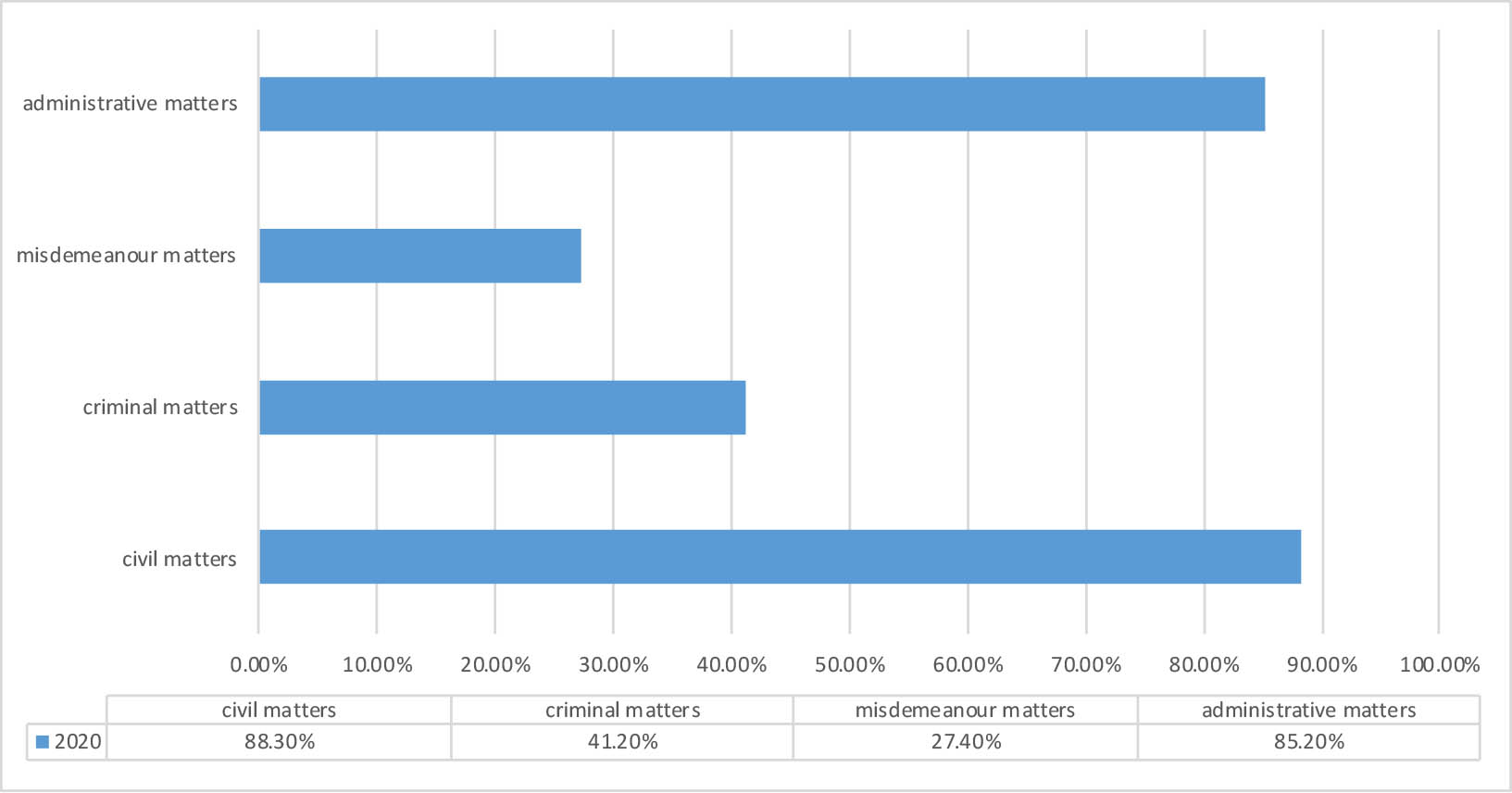
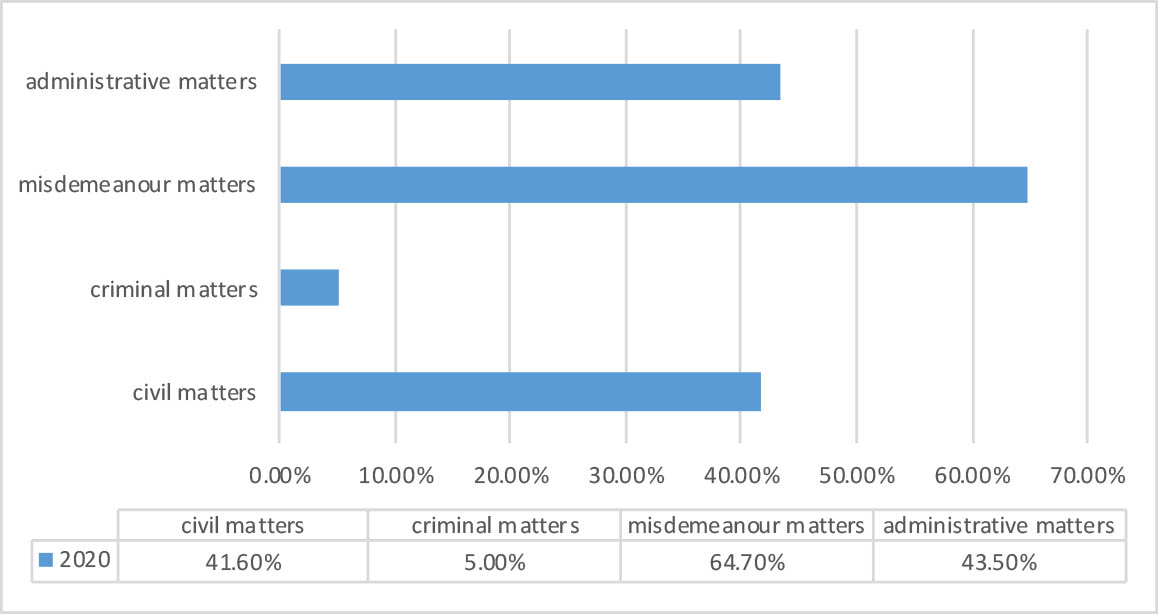
____________________________
[1] Background information – overview of crime in 2020 online: https://www.kriminaalp politika.ee/kuritegevus2020/. Criminal procedure matters are all criminal court proceedings brought before the county courts, which are divided as follows: preliminary investigation judge matters, matters of judges in charge of execution of court judgments, settlement proceedings, alternative proceedings, summary proceedings, general proceedings, administration of coercive psychiatric treatment matters, international cooperation matters and state legal aid matters.
[2] The total number of civil matters submitted to the county courts and matters of e-payment order expedited procedure submitted to Haapsalu Courthouse of Pärnu County Court have been indicated here, supervision proceedings are excluded.
[3] Online: https://www.kohus.ee/sites/www.kohus.ee/files/elfinder/I%20ja%20II%20astme%20kohtute%202020.a%20menetlusstatistika.pdf.
[4] The calculation is based on the specialization of judges and vacancies and long-term (more than 3 months in a row) absences from work.
[5] See online: https://kohus.just.sise/sites/kohtu/files/dokumendid/kis_uhtse_taitmise_reeglid_2019.a.pdf.
[6] Online: https://www.just.ee/sites/www.just.ee/files/news-related-files/khn_soovitused_kohtutele_eriolukorras.pdf.




